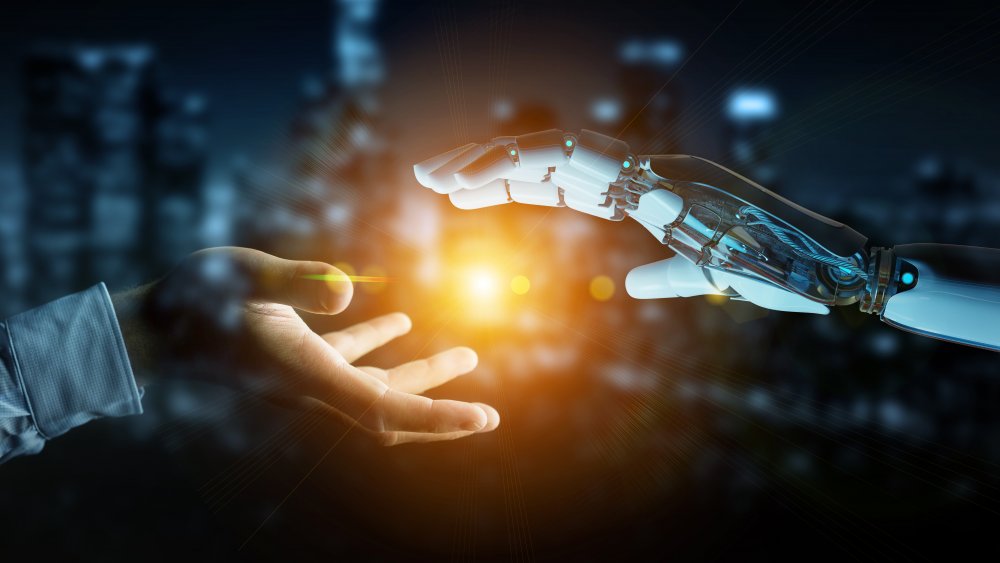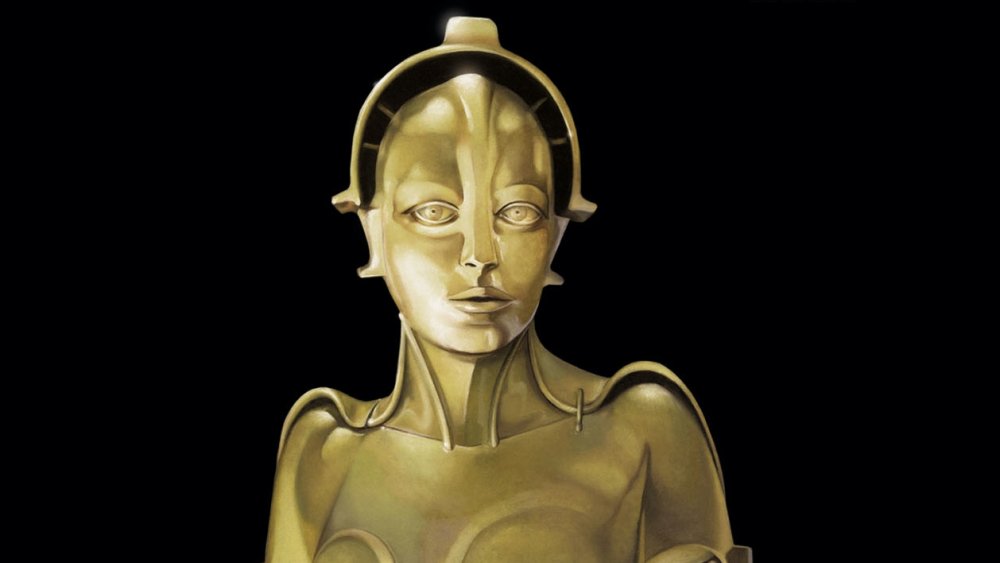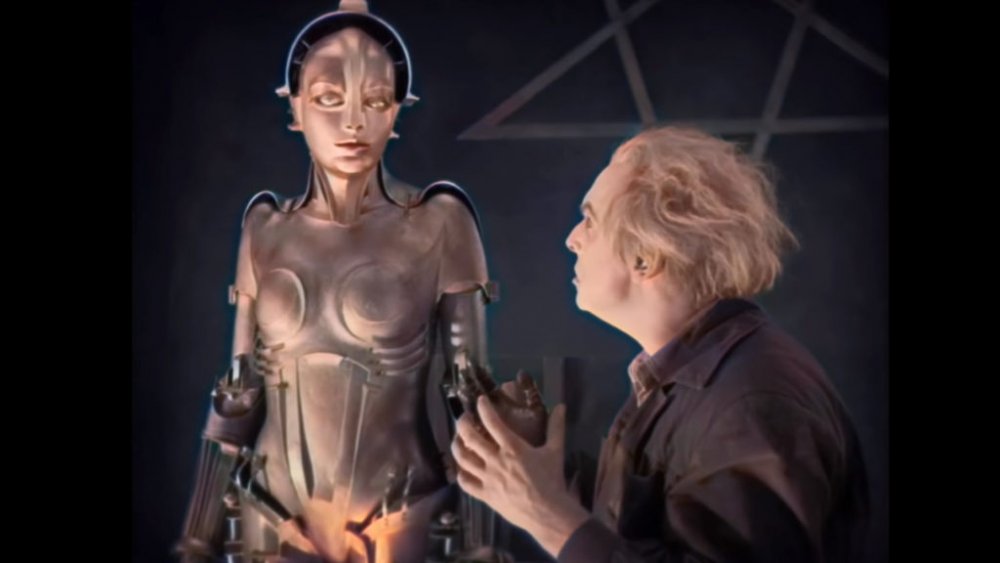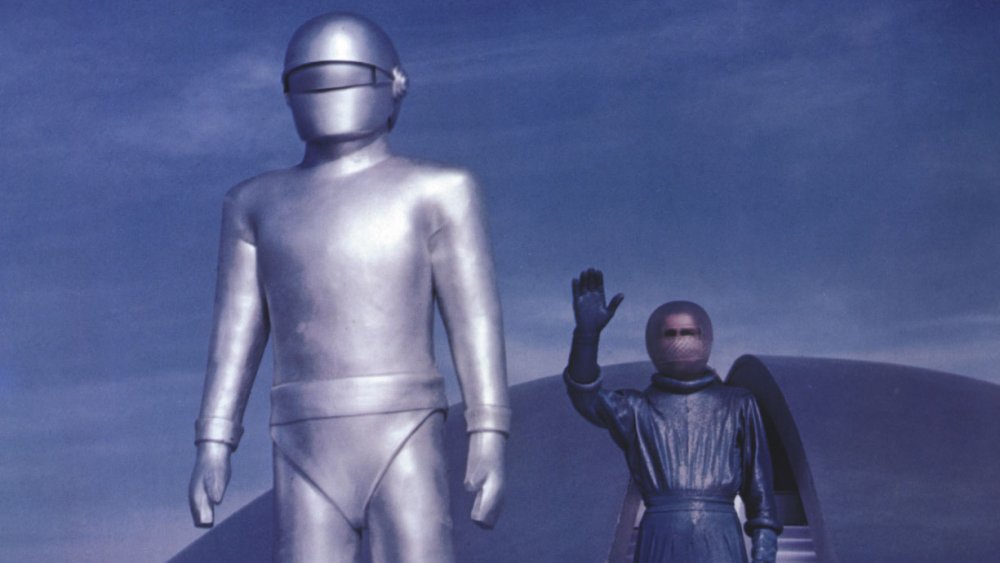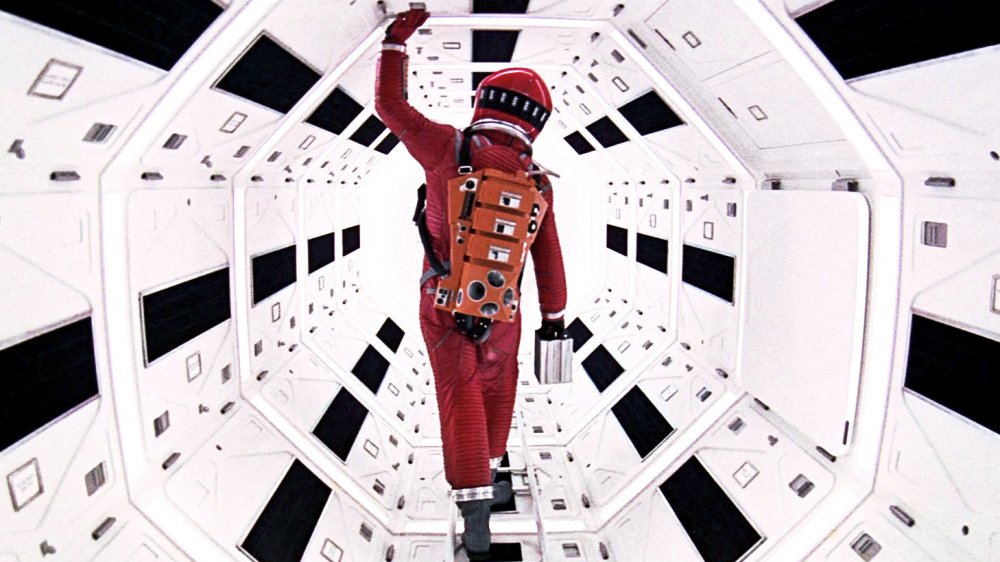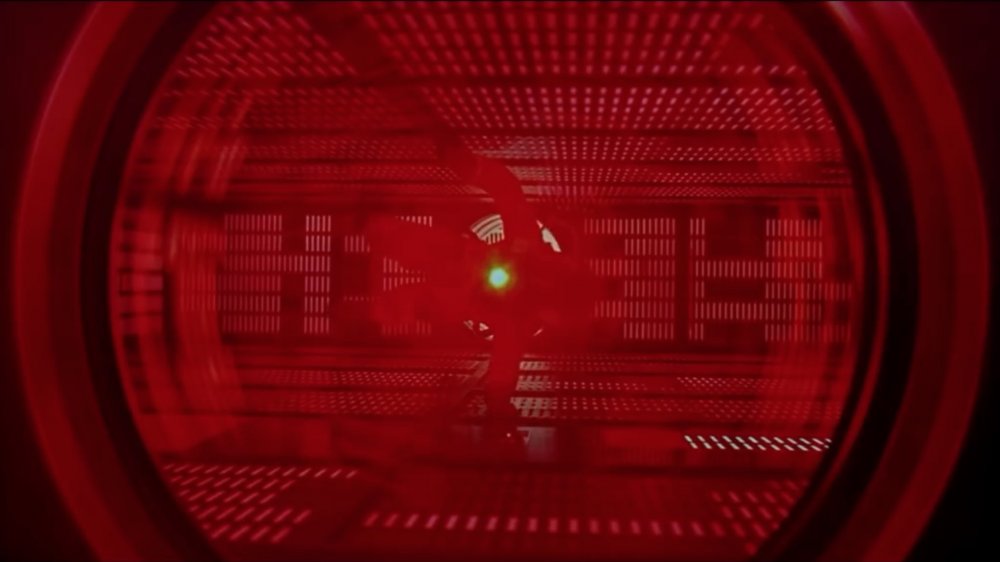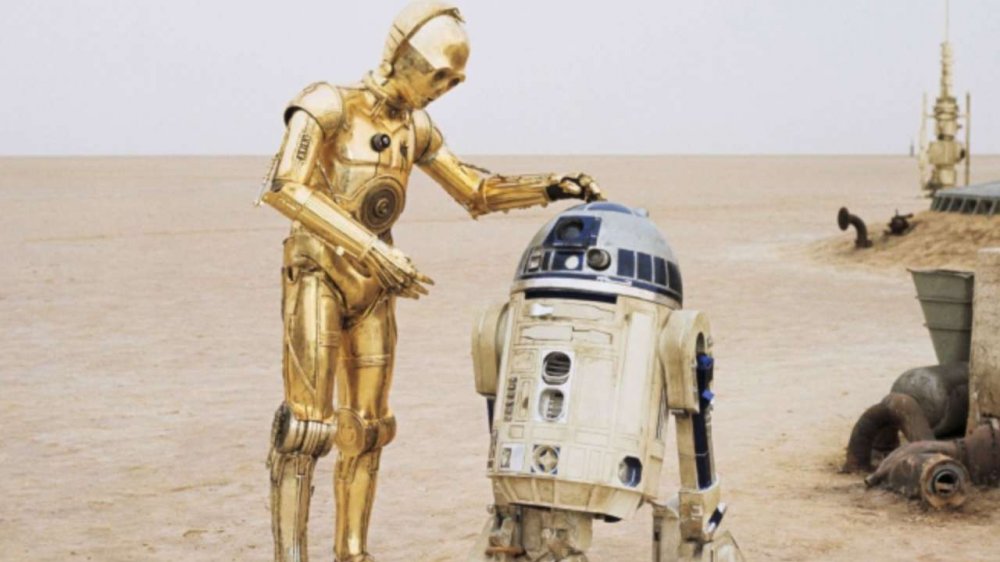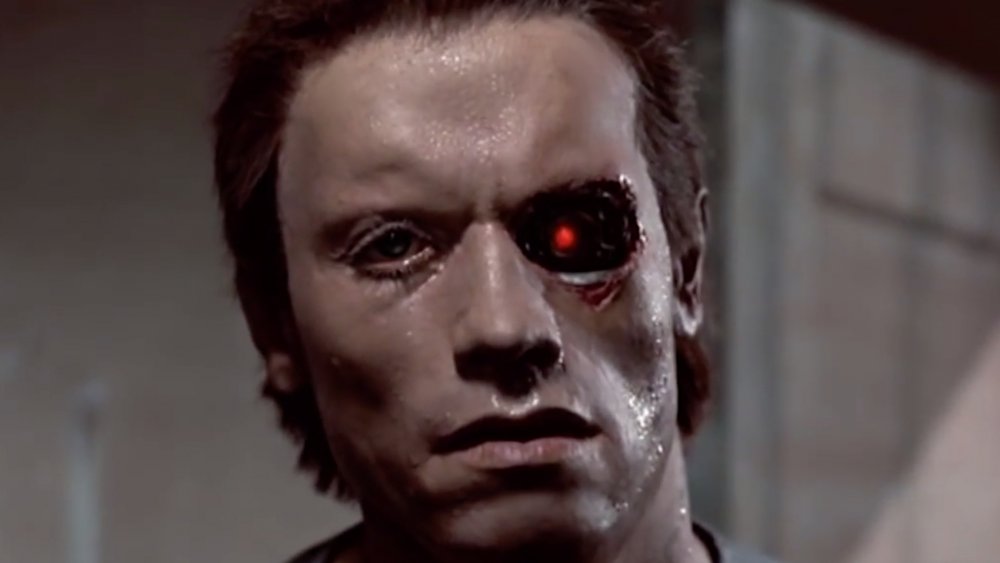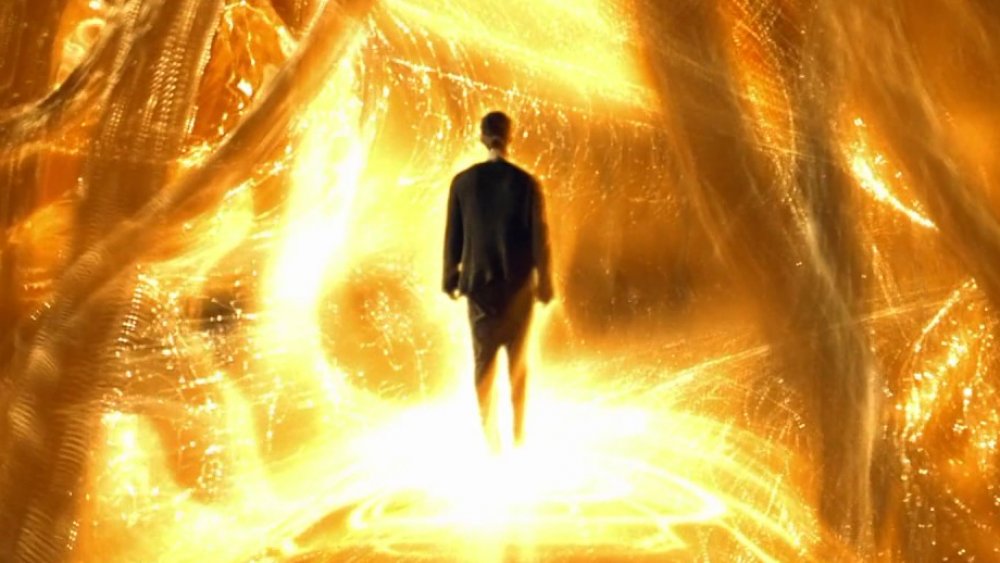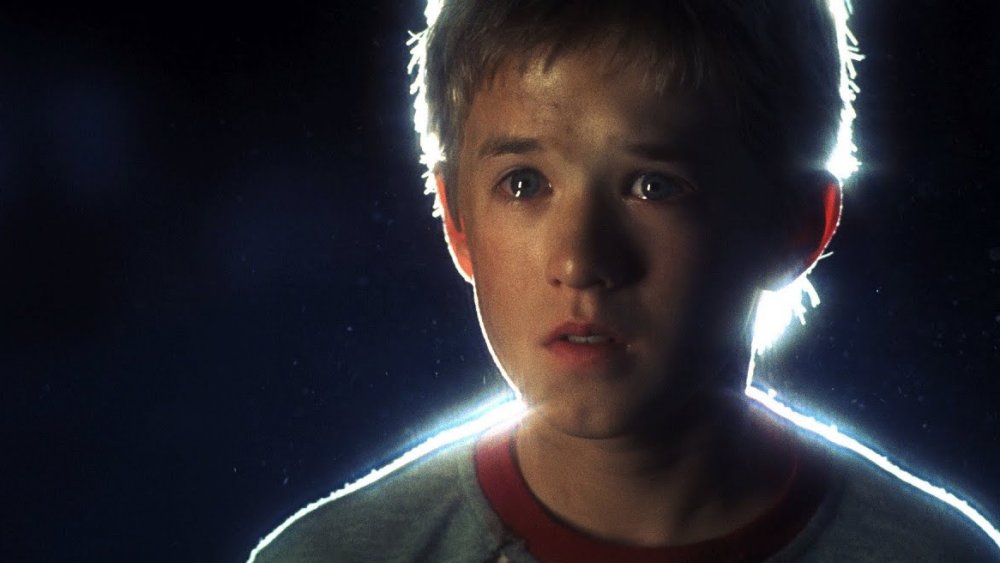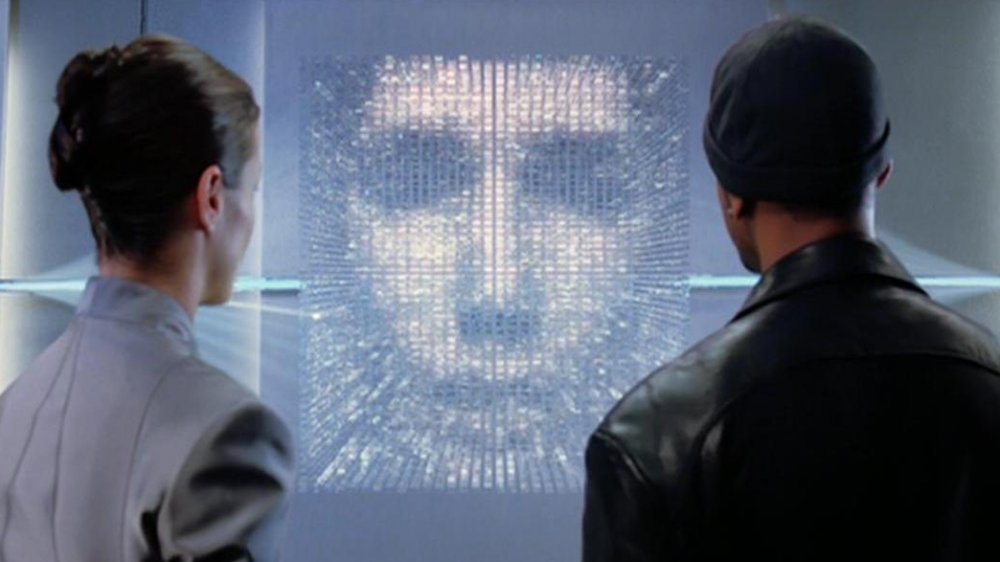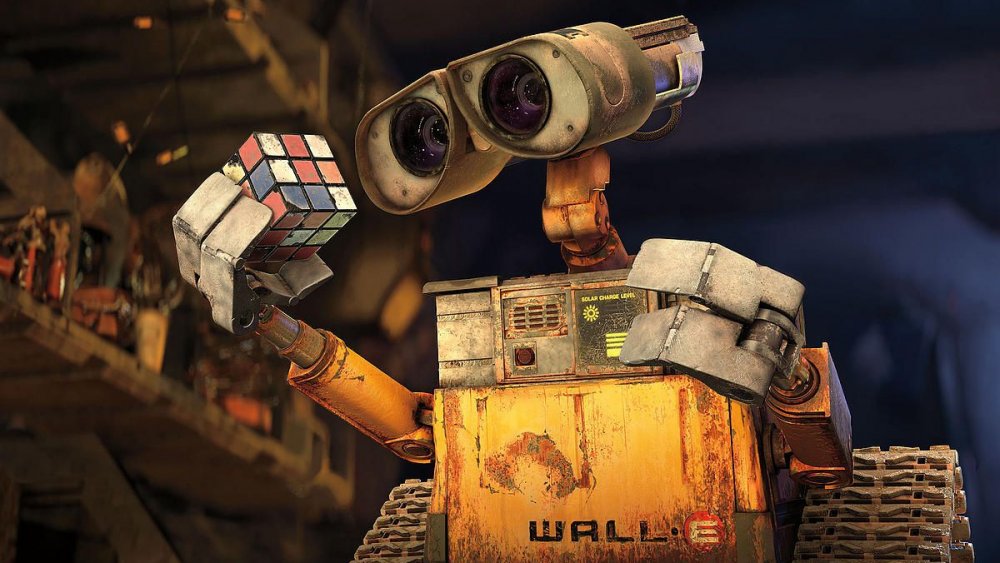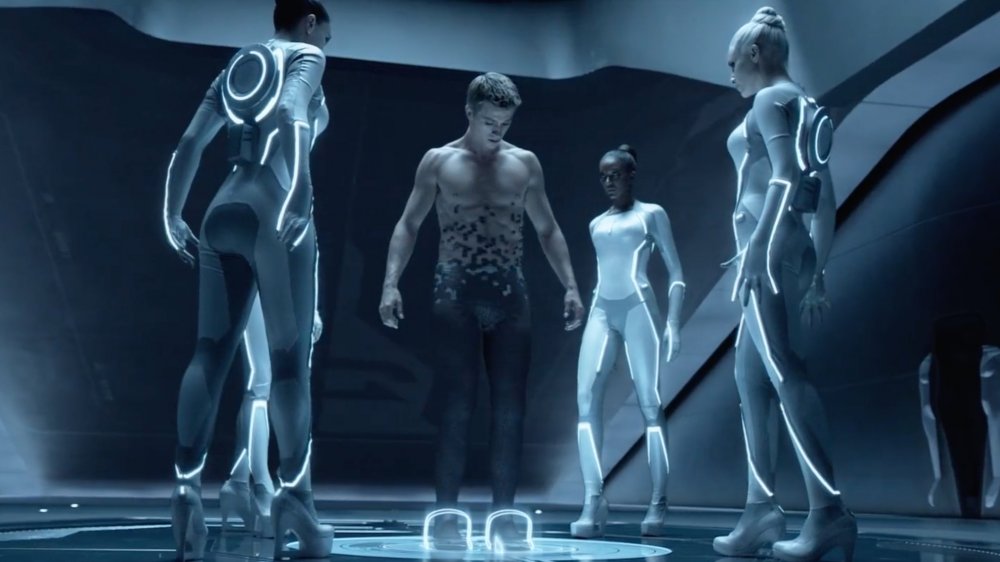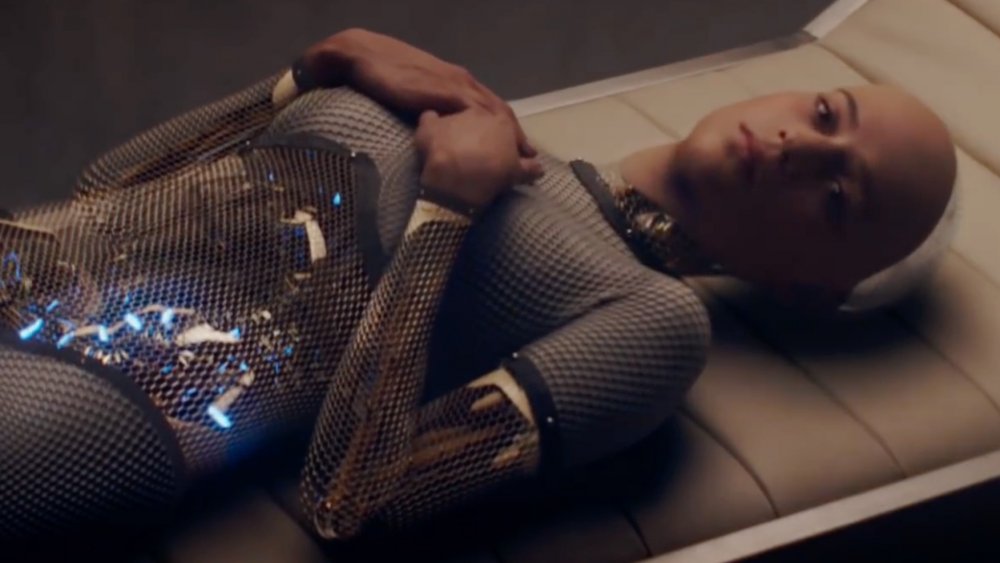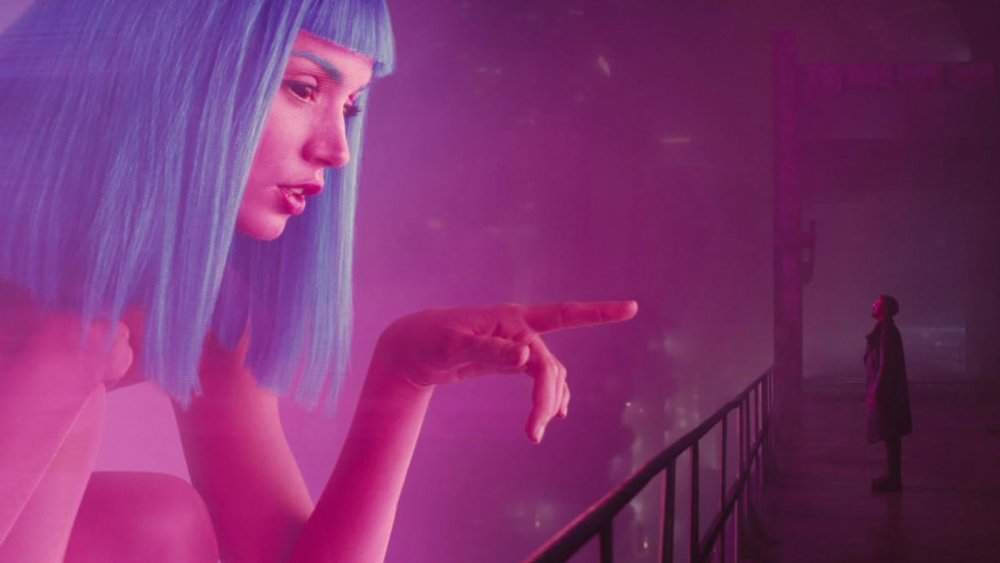The Stunning Evolution Of AI In Movies
The future has always held a special type of fascination in our movie experience. Inherent in all future timelines is the promise of what could be as well as the horrors of where we might be headed. As our technology advances further than sci-fi writers of the past could even imagine, so too does our concept of the power in artificial intelligence.
Whether it be imbued with the flaws of humanity or a slave to cold, calculated logic, AI has fascinated moviegoers for over half a century. You could argue that the creative landscapes in sci-fi films of the past, along with the ability of life to imitate art, helped dream up the supercomputer in your pocket. Your slender box of cat photos may be a far cry from the hauntingly emotionless robot that rocketed Stanley Kubrick's hapless astronaut into the cosmos in 2001, but just a few years ago, what still seemed like a distant future has now danced into our collective psyche through incredible visual effects. Combine our new ability to render abstraction into intoxicating splashes of color with the melodic voices of Scarlett Johansson or Paul Bettany and you are left with a final product that is not the AI of the future but a character of the present. With all that in mind, here's a look back at the stunning evolution of AI in movies.
Artificial intelligence makes its film debut
Many might guess that film audiences were introduced to the concept of hyper-intelligent robots around the same time we started aiming rocket ships at the moon. The truth is that in 1927, director Fritz Lang created an impressively forward-thinking depiction of AI in the German silent film Metropolis. In this dystopian future, the wealthy higher class rules from within skyscrapers over demoralized workers who live underground running all the machines for the city above. Freder, the son of the city's main proprietor, finds himself in the underbelly of the city among its workers where he learns of the harsh living conditions and chooses to abandon his ivory tower, joining the masses below. His father orders one of his head mechanics to convert a robot into the likeness of Maria, the woman Freder has fallen in love with. Using the robot in his attempt to maintain control goes horribly awry when the AI begins an uprising among the workers below. The film reaches its climax with Freder witnessing what he believes to be the real Maria being burned at the stake only to reveal a robot skeleton beneath the melting flesh. Cue the silent dialogue text: "Oh, the horror!"
Audiences say no thank you
Despite special effects that were considered incredibly innovative, Metropolis' storyline wasn't widely embraced at the time of its release — in fact, the film was ridiculed by sci-fi legend H. G. Wells. Numerous critics found fault with the film for its two-hour run time and called the plot ludicrous. In a time before penicillin, the idea of a machine impersonating a human being seemed a bit too farfetched to achieve mass appeal. The introduction of AI in this film also implied nefarious intentions in a time when people had no need to be reminded of the harshness of life. Being that movies themselves were a new experience, perhaps we weren't ready to share the screen — or maybe we didn't fully understand what it was. It could also be that even the director himself expressed a disdain for the film upon learning of the Nazi party's love for its supposed message. Whatever the reason, the concept of AI robots sat on the shelf for almost 25 years until it was paired with a visitor from out of this world.
Klaatu's AI defense system: Gort
In 1951, movie audiences were introduced to a future classic in The Day The Earth Stood Still. At the start of this black and white film, a flying saucer lands in Washington D.C. and reveals a stoic defender in the robot Gort. This extremely powerful AI — capable of turning our military's weapons to dust — is entirely under the control of an alien named Klaatu. Throughout most of the film, Gort simply stands guard over the spacecraft while the story unravels elsewhere. By this point in time, audiences had seen such technological advances as radar and the atomic bomb. The concept of controlling an intelligent robot was no longer unimaginable or ludicrous. If anything, it was kind of cool.
The Day the Earth Stood Still depicts artificial intelligence as a guardian that can be controlled and used for good, although this isn't immediately apparent in the plot. It isn't until the end of the film that Gort is given his commands and scoops up his master before departing Earth. The movie demonstrates a wonderfully diverse view of AI in both how it could be used in the right hands and how it would be perceived by its enemies. It's also shown as a device that can be used to achieve goals our fleshy bodies aren't capable of reaching alone — but one without character or emotion. It would be more than two decades until the world would be transported to a galaxy far, far away and introduced to the lively robotic antics of two cultural icons.
But first... a Space Odyssey
The biggest leap forward in the mainstream movie audience's understanding of artificial intelligence came from one of the cinematic greats himself: Stanley Kubrick. Taking place mostly inside a spacecraft bound for Jupiter, 2001: A Space Odyssey put forth a revolutionary display of light and sound that raised many existential questions about humanity, but the standout performance came from a single red bulb. Behind the crimson glow was the artificial intelligence system HAL-9000. All the ship's operations ran through HAL, who also had the ability to carry on casual conversations in an emotionless, monotone voice while the glass dome containing his red bulb was staring back at you. It was a remarkable new development in the representation of AI in movies. While HAL did seem to have his own unique personality, he was still restricted by his programming, which would ultimately lead to his demise.
My mind is going
We learn in 2001 that HAL's primary directive — hidden from the crew — is to ensure the arrival of the spacecraft at its destination to investigate the first evidence of extraterrestrial life. Being that his emotional range was restricted to ones and zeroes, he lacked the understanding to see a need for the humans inside the ship to be a part of that successful arrival. During a scene in which the film's main characters hold a discussion in a soundproof environment about shutting down HAL, the audience observes the AI deciphering those plans via lip reading. He sees this as a threat to the mission and kills most of the crew before the last surviving crew member reaches his processing center and shuts him down.
During the shutdown, we feel as though HAL is actually afraid. The audience knows it's necessary, but he evokes sympathy as we watch him slowly being destroyed. Unlike HAL's predecessors, the AI in this film was no longer just a tool, but a character with whom we can identify — a conceptual seed that grew into many of the characters we know and love today.
A long, long time ago...
In 1977, filmgoers all over the world were introduced to a whole new universe in Star Wars: Episode IV – A New Hope. Along with this galaxy came two of cinema's most well-known characters — the droids R2-D2 and C-3PO. These two immediately distinctive personalties have become so beloved that it can be easy to forget they are in fact robots with AI processors. While adding priceless comic relief to the story, Star Wars also introduced the language capabilities of C-3PO as well as R2's seemingly limitless ability to manipulate any type of machinery. Both robots were also able to hold conversation and display emotions that enriched the story and pulled us into their world. Star Wars showed us that the AI of the future was not just a weapon or a tool to be harnessed for our own goals — it showed us that AI devices could be valuable companions, too. These AI robots were friends that not only assisted with technological difficulties but stuck by their human masters' side — and helped viewers feel less lonely in the vacuum of space.
The Skynet's the limit
Along with all of the promise of what could be possible also comes a warning of might come to pass. For many years, AI was painted as a villain with a penchant for destruction. In the 1979 film Alien, for example, one of the human characters in the film is revealed to be an android. While the crew is fighting on their spaceship against a malicious alien life form, this AI system's programmed mission leads it to consider human life expendable and preserve the extraterrestrial. This once again calls into question the possible harm a coldly analytical robot can cause when subject to the whims of man. Five years later, the arrival of The Terminator imagined a post-apocalyptic future dominated by the artificial intelligence network known as Skynet and the horrific results of its efforts to wipe out humanity as a plague needing to be eradicated. Skynet sends a ruthless killing machine back in time with the mission of killing a woman named Sarah Connor, thus preventing her from giving birth to the son who'd grow up to destroy the AI network. Brought to life by Arnold Schwarzenegger, this robot's glowing red eyes raised new questions about our future with artificial intelligence. What if we're ultimately unable to maintain control over our own creation?
The battle for the soul of AI
Questions of the good and evil in artificial intelligence danced around writing rooms in Hollywood for many years. In WarGames, an artificial intelligence system in control of our missile defense systems at NORAD must be taught the futility of worldwide nuclear war via a game of tic-tac-toe. In Terminator 2: Judgement Day, Arnold Schwarzenegger's Terminator character — the cyborg who was the villain in the original film — turns hero. Near the end of the 20th century, Morpheus pulled the wool back from over our eyes and showed us the truth about the world we live in through the franchise-spawning hit The Matrix. Presumably a slave to his programming within the Matrix, the enigmatic Agent Smith argued at length that humanity was a virus for which machines are the cure. Throughout this decades-long creative dance over the morality of artificial intelligence, an underlying message became clear. Perhaps AI is the future and the only thing holding back its advancement is its creator: humanity itself.
The electric sigh
The 1999 animated film The Iron Giant showed us the softer side of artificial intelligence, offering a much-needed injection of innocence into the public's perception of AI. The titular robot has an almost childlike demeanor and approaches the world with curiosity; any animosity towards humans is merely a reaction brought on by his programming, and through his own display of sentience, he's able to overcome his coding and sacrifice himself to protect people rather than use himself as a weapon.
Viewers' hearts were melted again in 2001 by the child robot David in the aptly named A.I. Artificial Intelligence. The robot in this film was made for only one single purpose: to love and be loved. The story for this film, conceived by Stanley Kubrick and finished by Steven Spielberg after Kubrick's passing, serves as an interesting step in the development of artificial intelligence as a narrative device. Although at this point it had been in movies for many years, AI was still in its infancy. Maybe it was time for it to grow up.
This is for your own good
Parents have always done many things that don't make sense to their children until later on in life — so it stands to reason that an AI "parent" would behave much the same way. Take that idea, amplify it to six billion souls, imagine a processor capable of more thought processes than all those souls combined, and you're left with a matriarch that may very well decide that all of humanity needs to be grounded until the end of time.
This is what movie audiences see in the AI system known as VIKI, the surprising antagonist in the 2004 Isaac Asimov adaptation I, Robot. Throughout the film, the audience is told about laws that govern the robots of the story's world, restraining them from ever harming a human being. However, VIKI distorts these laws and interprets them on a grander scale: harm brought to a few is acceptable if it leads to the preservation of many. This same concept is also essentially the motivation behind the AI system in the 2008 espionage thriller Eagle Eye. As artificial intelligence in movies began to develop more human characteristics, it also took on more human insecurities. Being that these systems are obviously capable of more computing power than the human brain, maybe they know us better than we know ourselves.
I think, therefore I am
As we moved into the 21st century, our technology leaped forward with dizzying speed — advancements in personal computers, including our very own AI right in our pockets. Movies had already helped lay the groundwork for the personality templates in these new systems. The symbiotic relationship between mankind and its new technological companion was perfectly represented in J.A.R.V.I.S., Tony Stark's AI, as introduced in Iron Man, the movie that also kickstarted the modern superhero craze.
Pixar further blurred the lines between artificial intelligence and human emotion in WALL-E, which encouraged the audience to project its emotions onto an adorable robot and largely removed human beings from the story altogether. Let us also not forget how Alan Rickman's delightful voice resonated from within the clinically depressed robot Marvin in the film adaptation of Douglas Adams' classic The Hitchhiker's Guide To The Galaxy. All these films explored the possibilities in the relationship between human beings and artificial intelligence. Steadfast companions, tireless protectors, comic relief — AI characters had gone from emotionless novelty characters to a part of the narrative fabric of our cinema. They also displayed how our humanity was leaking onto their motherboards.
Ghosts in the machine
The 2010s brought forth a surge of AI characters in film. To start the decade, we were transported into the computing realm itself through Tron: Legacy. A sequel to the 1982 cult classic Tron, Legacy inverted our association with AI in our world by taking us into the computer's world. Nearly every character in the story is essentially a computer program visualized as humanoid, and the primary antagonist in the film is driven by his desire to be real — to exist in the human world.
Not long after Tron: Legacy's arrival, we revisited the world of Alien with the prequels Prometheus and Alien: Covenant, which continued the franchise's tradition of duplicitous android characters. We watched a lonely Joaquin Phoenix fall in love with an AI system voiced by Scarlett Johansson in Her. In this past decade we've followed along as filmmakers have explored a new technological landscape, testing the limits of what's visually possible — and what our AI characters can become.
You can talk to me
The line between disbelief and truth blurs in Ex Machina, shedding a disturbing yet compulsively watchable light on the difficulty of determining what it means to be human. The story makes the viewer so intent on observing the AI robot Ava for signs of humanity that it's easy to forget one of our most unfortunate capabilities: deceit.
The implementation of this type of independent thinking has shown us that AI characters are no longer pawns on the storyboards of film, but beings to be closely watched — and respected in their own right. We quite literally saw this play out with the creation of Vision in Avengers: Age of Ultron, when he goes from the disembodied voice of J.A.R.V.I.S. in the background to a superhero in his own right, grabbing hammers and smashing bad guys. (Now we're eagerly standing by for more Vision in the Disney+ exclusive WandaVision.) The past has shown us that AI can be flawed, but now the flaws shine through not as mistakes in the code but quirks in character — qualities that make these characters more human.
Visions of future past
At times over the past decade, it's seemed as though we've all been part of a giant sample pool subjected to the film industry's very own Turing test. Westworld does a remarkable job of showing the audience a view of the journey into sentience through the eyes of artificial intelligence itself. Blade Runner 2049, the 2017 sequel to Ridley Scott's cult classic Blade Runner, further explores the original's questions regarding what it truly means to be human, while Alita: Battle Angel features a cast of AI characters that share screentime with their human counterparts.
Admittedly, many of Alita: Battle Angel's "more human than human" characters have human brains operating robot bodies, but that's just the point: the line between the two has been blurred beyond recognition. AI characters are no longer just robots in the background taking orders, subject to the whims of our heroes and villains. They're now truly characters in their own right, and they're here to stay. So the next time you ask Siri to direct you to the nearest Starbucks, maybe ask her how she's doing — the answer may not surprise you, but she might appreciate it.
